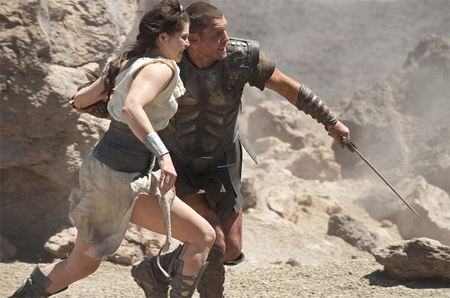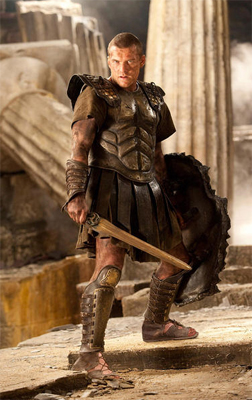Even as a lad, I was not a fan of the 1981 version of Clash of the Titans. A grade school teacher, detecting some faint whiff of precocity, suggested that I needed to investigate Roman mythology. Not wishing to disappoint her, I checked out a 200-page book on Roman mythology from the school library. It contained striking illustrations and offered a kid-friendly overview of the gods. I spent several days alone in my bedroom, reading it over and over with more devotion than any variation on the King James Bible. Some of my mother’s wild-eyed friends, sensing that I was an uncommon reader, attempted to get me to read more ecumenical texts. But I was suspicious of these gestures. I didn’t understand then why one needed to choose a religion. If you had to select one, why not place your faith in these marvelous stories? Medusa! Cerberus! Narcissus! Prometheus! The tragedy of Orpheus and Eurydice! These tales all captured my imagination so much that I found myself flipping through the Yellow Pages, wondering if there were any churches devoted to Zeus or Aphrodite.
Seeing no division for “Roman” or “Greek,” I nervously telephoned a few churches when my mother was away, asking where one could go to worship the gods. One man told me that surely I meant a singular one. “No, no, no,” I replied. “I’m talking about the Gods of Olympus!” There were efforts to steer me towards the “true” faith, but I proved recalcitrant. I concluded that religion was not for me, but I still begrudgingly went to church when I was asked and I did my best to keep my mouth shut. Although one congregation member would later say, “There’s something of the devil in that boy.” For all I knew, he was probably right.
So when the Clash of the Titans lunchboxes started showing up in the cafeteria, and when some of the kids began speaking of this “great” film, and when I continued to wonder about the mechanical bird (who reminded me of Tick Tock from the Oz books), I felt obliged to figure out a way to see this movie. I knew the name “Ray Harryhausen” from the amazing stop-motion effects seen in the Sinbad movies that repeatedly aired on UHF stations. And while the Medusa sequence impressed me, the Perseus depicted in Clash (played by a doe-eyed Harry Hamlin) reminded me of the sleazy and self-absorbed men — some strange phase between disco king and yuppie — who drove loud sportscars when I looked out the car window. This Perseus couldn’t possibly compare to the one I had imagined from the books. What was the big deal?
So it’s safe to say that the original Clash didn’t make much of an impression. And now that I’ve had the misfortune of revisiting the original film, I can safely say that it contains very little of value aside from Harryhausen’s effects. Even with the prominent matte lines and the inconsistent lighting between the animation and the live action, Harryhausen remained a consummate master of the tiny gesture that spelled out everything you needed to know about a creature. The specific way that Pegasus kicks up his forelegs or the manner in which the giant hawk waits for Andromeda’s soul to enter the cage. And, most impressively, the way that the Kraken burrowed his three claws into the rocks and peeked his menacing head over the ravine. This attention to detail made these seemingly one-dimensional characters live in my mind.
So it is my sad duty to report that the Clash remake, while not nearly as terrible as I expected, doesn’t possess a singular creature gesture to match Harryhausen’s. Gargoyles flap about into a giant mass. There are a few giant scorpions that prove somewhat enthralling. Pegasus, who is referred to not as “Pegasus, the last of the flying horses” (as he was in the original) but merely “the Pegasus” (well, if he isn’t unique, then what’s the big deal?), has been integrated, by way of jet hide, into some strange affirmative action program. It’s clear that the animators are inputting coordinates into a computer. The time for careful attention to monsters is now mostly finished.
Which is too bad. Because Sam Worthington is better as Perseus than that dreadful slab of inexpressive meat (the suitably named Hamlin) cast in the original. While there’s something more than a bit odd about seeing a 33-year-old actor referred to as “boy,” and Worthington appears remiss to show off his pecs in the exhibitionist manner that Hamlin (or director Desmond Davis) was all too eager to practice, Worthington is never insufferable. Alas, his Perseus is less committed to taking charge. He bitches about going back to his old life as a fisherman. He is never given an invisible helmet, as he was in the original, much less a shield from the gods.
Instead of Burgess Meredith, Perseus is accompanied by two mercenaries, who speak some bad dialect that is vaguely Russian and vaguely Slavic, but ultimately the product of lazy Hollywood acting. (When this duo first appears, the film is quick to insert some gypsy music track, as if we won’t notice just how terrible they are. All that money for the effects and the filmmakers couldn’t hire a dialect coach?) Indeed, one of this movie’s curious qualities is that there is no uniform dialect. Some actors speak with an Australian dialect; others, Santa Monica; still others, British. And this slipshod attention to language should give you a sense of where director Lewis Leterrier’s priorities are.
Perseus is constantly under the tutelage of Io (played by the inexpressive Gemma Arterton), who has been watching him all his life. (Never mind that we don’t see her until midway through the film.)
In other words, 2010’s Perseus reflects the vitiated masculinity often found in the insufferable hipster too intoxicated with his own indolence.
But that’s the least of the film’s problems. Given that the original film featured Ursula Andress’s ass and a breastfeeding moment, I was surprised that the remake’s eleventh-hour upgrade to 3-D (reportedly assembled in eight weeks) didn’t take advantage of these Z-axis possibilities. It becomes very clear early on that this movie was never designed with 3-D in mind, and that audiences are being gouged. Clash‘s 3-D “experience” merely involves accentuating planes of focus. One would get livelier surprises from a pop-up book. And the film’s reticence to display blood and visceral fluids (much less the nude form) makes one wonder how this movie landed a PG-13 rating. Yes, there’s a scene in which Perseus cuts his way out of the inside of a computer-generated scorpion. But it all seemed artificial to me. Not just because the film never lets a creature have even ten seconds of camera time to offer some personality, but because we are never given a gesture in which we can believe in the scorpion.
I should probably also mention the remake’s casual misogyny, which comes courtesy of screenwriters Travis Beacham, Phil Hay, and Matt Manfredi. The original film, you may recall, was somewhat careful with the gender balance. There was Thetis’s statue that came alive. Athena and Aphrodite were given some moments. When Perseus declared that he was going to pursue the Stygian witches on his own, Andromeda stood her ground, saying, “No, we will ride with you as far as their shrine. It is a long and perilous journey.” And when Perseus busted out some macho swagger, Andromeda pushed back. Then, with a schmaltzy music cue from Laurence Rosenthal, Andromeda rode forth with her horse, shortly announcing, “We follow the North Star.”
This may not have been much, but at least the women in the original Clash got the chance to engage in a little action. By contrast, the remake has pushed all the goddesses out of the narrative, leaving only Zeus (Liam Nesson) and Hades (Ralph Fiennes) to duke it out with humans as pawns. In the remake, Andromeda doesn’t accompany Perseus on his quest. And it isn’t too long before Io, in a preposterous moment aboard Charon’s ferry, soon becomes little more than a sex object, urging Perseus to “ease your storm.” And it was here that the film lost me. Granted, defenders of this remake (will there be any?) will no doubt respond to my criticisms by pointing out that Io tries to teach Perseus some moves to battle Medusa. But Io never makes any real effort to put Perseus in his place. The film’s anti-women attitude can also be found in the Medusa sequence. Medusa, in the original, was an ass-kicking serpent who fired arrows at Perseus’s comrades. She was a formidable villainess whose omnipresent rattle was enough to command attention. But in the remake, all Medusa does is offer random laughs and slither around her lair. And if that isn’t enough for you, consider the needless explanation for Medusa’s transformation in both films. The original simply mentioned that Aphrodite punished her. The remake offers a description of rape, painting Medusa as a once very beautiful woman. It’s almost as if the filmmakers are suggesting that the bitch had it coming.
So if some kid is coming into this movie, hoping to find some halfway house with which to move onto the likes of Edith Hamilton, then the Clash remake is mostly futile. As my pal Eric Rosenfield was adamant to observe, the film doesn’t even get the mythology right. (Perseus does not marry Andromeda in this movie.) It doesn’t even have the decency to give us Dioskilos, the cool two-headed dog that Perseus’s army fought before Medusa. It does wisely divest itself of Bubo, the mechanical bird from the original, giving it, quite literally, a throwaway cameo. And again, I cannot stress enough how anticlimactic the 3-D is.
I’ve seen movies that are worse. But when you’re dealing with mythological wonder, why settle for less?






